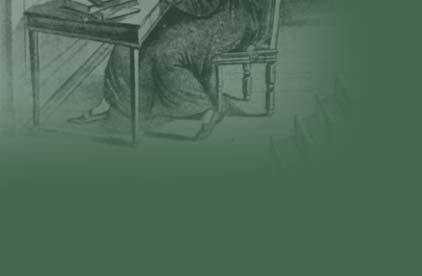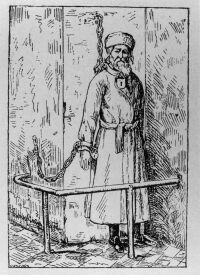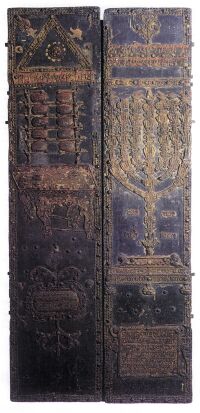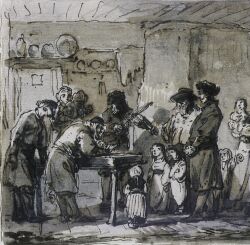





The jewish criminal locked in "kuna" in the antechamber of the synagogue in the suburbs of Lwów. In the Jewish judiciary in Poland there were meted out such punishments, as fine, inprisonment, anathema and exclusion from the commune. Those punishments deprived the culprit of the right of chazaka - the right to live in the city. Other punishments were imposed by the city hall, starost's office and subvoivode's office.
Parochet - curtain covering the door to Aron ha-Kodesh, end of the 17th century.
This curtain symbolically separates the sacred (sacred chests containing the scrolls of Torah) from the profane. It was ceremonially pulled back during the service, when the Scripture was being taken out.
Rabbi Samuel Eliezer Edels (ca. 1560-1631).
Samuel Edels was a rector of the Poznań's yeshiva, rabbi in Chełm, Lublin and Ostróg. He wrote a commentary on Talmud: Hidushe halahot we-agadot.
Grave slab (maceba) of the Kraków's rabbi Moses Isserles. Remuh cemetery, Kraków, 16th century. The inscription says: "Here lies the great man, according to a count of the year 377, our teacher, rabbi Mordechaj Saba. Man of thorough knowledge of the nature, eminent grammarian, cabalist and preacher, as rabbi Chabiba. In his youth he contented himself - as rabbi Hanina - with the measure of a carob. He supported good with the God's glory shinning constantly on his mouth..."
|

Wooden door to Aron ha-Kodesh, Remuh synagogue, Kraków, beginning of the 17th century.
On the right side of the door there is menorah with the inscription saying: "Speak unto Aron, and say unto him, When thou lightest the lamps, the seven lamps shall give light over against the cadlestick" (Numbers 8, 2). On the left side of the door there are loafs of bread on the shelves with the inscription: "And thou shalt set upon the table shewbread before me always" (Exodus 25, 30).
Jewish marriage contact (ketubah), between Szulima Lewkowicz and Marianna Leyzorowicz, 1743. The groom presented ketubah to his bride during the wedding ceremony. It specified the husband's obligations towards his wife and guaranteed her provision in case of his death or divorce.
Page from the prayerbook (siddur), made probably in Kraków at the turn of the 15th century. The prayerbook is handwritten on parchment. It includes calendar, instructions for the Sabbath and prayers. It once belonged to well-known Hasidic rabbi, Izraela Friedmana of Ruzhyn near Kiev (died 1850).
Interior of the synagogue in Łańcut, drawing by Zygmunt Vogel (1764-1826).
Built in 1761. Currently the Judaic museum.
|

Jewish musical band, drawing by Jan Piotr Norblin, 1778.
The Jews often amused themselves with the music. The weddings were particularly noisy and sometimes more sumptuous than the parties at the noblemen's manors.
The Jewish district in every of the major cities esteblished the commune (kahal), with the rabbis and the elders as its head. All the Jewish population was under their authority, and the Christian municipal council had no right to interfere in the commune's competence. Kahal was responsible for raising and maitaining the synagogue, kirkut (Jewish cemetery), mikvah (bath-house) ond other public utility buildings. It took care of the schools, judiciary and tax collection.
Every commune had it's own school, because learning of reading and writing was obligatory. The Jewish boys started learning already at the age of four at schools called cheder. In some cities, e.g. in Kraków, Lublin or Lwów, there were established talmudic schools (yeshiva; pl. yeshivot), where the youth studied Torah (Five Books of Moses) and the commentaries on it.
Shkolnik (shames) calls for the prayer to the synagogue. Shames called the faithful to the synagogue using a rattle or wooden hammer, with which he knocked into the Jewish homes doors. The pious Jews went to synagogue even twice or three times a day, spending there much time on praying and studying Torah. |

